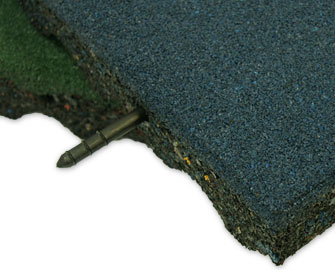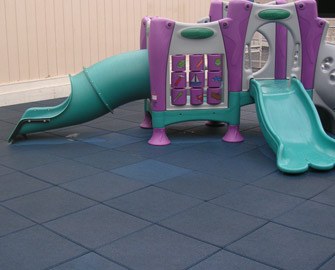|
|
Both rubber mulch and rubber playground surface tiles are made of recycled rubber crumb, giving them both unmatched durability and resistance to damaging environmental factors. Rubber crumb surfacing tiles are the best playground flooring option, rather than rubber mulch, as they offer uniform shock absorption throughout the entirety of the playground. Unlike rubber mulch, a loose-fill material, safety play mats are interlocking tiles are unitary surfacing products whose shock absorption will not be affected by any physical or environmental factors. With 4 thicknesses of the tiles available, it is easy to create a sufficiently padded play area in both indoor and outdoor settings. Best of all, because their shock absorption will not be affected by physical and environmental factors, playground surface tiles will not need frequent maintenance unlike loose-fill rubber mulch.
What are the Disadvantages of Rubber Mulch?
The biggest disadvantage of rubber mulch is that its safety properties can easily be compromised by changing physical and environmental factors; therefore, it is better to use recycled crumb rubber playground surface tiles. Playground rubber mulch is “made from recycled rubber, most often crumb rubber sourced from waste tires” (Wikipedia.org). Rubber mulch is a loose-fill form of rubber crumb surfacing that is tested in accordance with ASTM F1292. This form of rubber crumb surfacing must be laid with a specific depth to ensure sufficient shock absorption for a safe playground surface. For instance, according to the U.S. Consumer Product Safety Commission, shredded tire mulch must be 10 to 12 inches deep for it to provide enough shock absorption in case of a fall off the playground equipment (cpsc.gov). A major disadvantage to loose-filled rubber mulch is that the depth can easily be altered by changing weather conditions as well as from the wear and tear of children playing. Strong winds and rain can easily blow rubber mulch out of its containment area while running and kicking children can create an uneven depth, creating pockets within the playground surface that are not as shock absorbent. On the other hand, rubber crumb playground surface tiles will offer a level and even surface that is not affected by physical factors. Unlike rubber mulch, weather and wear will not affect the thickness of rubber playground surface tiles, allowing for sufficient shock absorption over the entire playground floor. Furthermore, rubber playground surface tiles are also offered in 4 thicknesses of 3/4", 1”, 2.5”, and 3” for a sufficiently padded play area, making rubber interlocking safety play mats the best playground flooring option available.

|

|
-
(a) How Long Does Playground Rubber Mulch Last?
Rubber mulch can last for years depending on wear and tear as well as changing weather conditions, but rubber playground surface tiles will last longer due to their solid composition. Both being made up of recycled vehicle tire crumbs, rubber mulch and rubber playground surface tiles are both extremely durable and resistant to environmental factors, including UV rays, ozone, oxygen, and moisture. Vehicle tires experience heavy wear and tear caused by both abrasive terrains and weather conditions, yet they are not seriously damaged by these factors. This durability can be seen in the performance of recycled crumb rubber mulch and playground surfacing tiles. However, because rubber mulch is a loose-fill material, its shock absorbency can be significantly altered over time. Loose-fill materials consist of loose particles, such as rubber mulch, wood chips, sand, or gravel, that are used to create a protective playground surface (cpsc.gov). As a loose-fill playground surface material, the effectiveness of rubber crumb surfacing mulch can be affected by changing weather conditions and the wear of children playing. Case in point, loose-fill materials will need more frequent maintenance to ensure proper cushioning as playing children and weather can cause the material to be displaced beyond the containment area where they were first laid (cauinsure.com). This, in turn, will require frequent refilling of the rubber mulch to maintain a sufficient depth to prevent serious injuries upon impact. Contrastingly, rubber playground surface tiles will not have this problem as they are solid products. They will last much longer as they retain all the environmental resistance properties as rubber mulch, but in solid form. Along with its excellent durability against damaging environmental factors, recycled crumb rubber playground surface tiles, unlike rubber mulch, will offer a uniform shock absorbent surface that will not be blown or kicked out beyond its containment area.
(b) Is Pea Gravel or Mulch Better for Playground?
Mulch is better for playgrounds than pea gravel, but rubber playground surface tiles are the best playground flooring option available. Pea gravel is “small, smooth round stones…with no sharp or jagged corners…” (playgroundresources.com). Although pea gravel is surprisingly shock absorbent, recycled crumb rubber mulch and playground surface tiles will offer better shock absorption due to its softer recycled tire composition. Both pea gravel and rubber mulch are loose-fill playground surfacing materials that will be easily affected by everyday wear and tear. Pea gravel and rubber mulch in areas, such as under swings and slide exits, can easily be displaced and made uneven, reducing the surfacing’s shock absorption as the depth is reduced. Contrastingly, recycled rubber crumb surfacing tiles are an interlocking surfacing option that connect to form a unitary surface that will not be affected by wear or weather. Best of all, its recycled rubber crumb composition offers superior shock absorption and anti-slip properties.
(c) What is Best for Playground Mulch?
The best for playground mulch is recycled crumb rubber, but overall, it is best to use recycled crumb rubber playground surface tiles. Although rubber mulch and rubber playground tiles are both made of recycled vehicle tires, rubber mulch is a loose-filled surfacing option and rubber tiles are unitary surfacing options. Rubber mulch must be 10-12 inches deep to ensure a sufficiently padded play area that will absorb the force of a fall. However, loose-fill rubber crumb surfacing options are easily compromised by physical and environmental factors. When children are playing, they can inadvertently kick out the loose materials – this is especially evident in areas under swings and slide exits. Additionally, changing weather conditions and wind can blow loose materials out of the designated play area. These physical and environmental factors can significantly reduce the shock absorbency of the playground surface. Recycled crumb rubber interlocking safety play mats will form a solid and uniform surface for shock absorption throughout the entirety of the playground surface and they will not be affected by weather or the wear of children playing.

|

|
(d) Can I Use Wood Mulch for Playground?
You can use wood mulch for playgrounds; however, it is recommended to use interlocking rubber safety play mats due to their superior impact absorption properties. Wood mulch is not a long-lasting playground surfacing material as it deteriorates over time in the outdoors. Case in point, “all organic mulch has a lifespan between five to six years. However, there are some cases where you will need to replace the mulch every one to two years. With any type of organic mulch, it can decompose and will need to be replaced” (charlestownlandscaping.com). Because wood much is an organic material, it is easily degraded by environmental factors, especially when used outdoors during wet seasons. In contrast, recycled rubber crumb playground surface tiles are highly resistant to environmental factors, including UV rays, ozone, oxygen, and wet weather. Made of post-consumer vehicle tires, recycled rubber crumb surfacing tiles will inherit the same environmental resistance. Its moisture resistance will also help its long life by preventing the growth of harmful microbial byproducts, like mold and mildew, from forming.
Compared to loose-fill rubber mulch, rubber playground surface tiles are the best playground flooring options due to their unitary design. Safety properties of loose-fill materials, such as rubber mulch, can easily be compromised by changing weather conditions and physical factors, such as playing children. Both surfacing options are made of recycled rubber crumb that derives from vehicle tires, playground tiles will offer better protection for longer when exposed to abrasive weather conditions. Strong winds and the wear of children playing can displace the loose rubber mulch and create unsafe playground surfaces whereas rubber tiles will remain in place. Additionally, compared to other mulch variations, like wood, rubber playground surface tiles will not degrade in the face of harsh environmental factors, including UV rays, ozone, oxygen, and wet weather. Overall, while rubber mulch is very durable and environmentally resistant, rubber crumb playground surface tiles are the best playground flooring option.
How Long Does Playground Rubber Mulch Last?
|
|
|